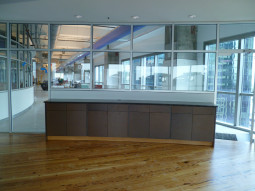 Wood flooring can give a commercial office, loft or retail space a warm and inviting look. Often there are additional specifications to consider from the sub floor, to sound, to even the color and matching components that may be more intensely specified than in a home.
Wood flooring can give a commercial office, loft or retail space a warm and inviting look. Often there are additional specifications to consider from the sub floor, to sound, to even the color and matching components that may be more intensely specified than in a home.
Questions to consider:
- How do you attenuate the sound transmission for 2nd floor or above installations?
- What if your client wants the floor to have specific or long lengths on a concrete sub floor?
- How do you match cabinetry or other color considerations on antique reclaimed wood?
When a holding company for an old family lumber company wanted antique heart pine on the 3rd floor the specs included:
- control the sound transmission
- match the color of the furniture
- match the height of doors at 1″ overall
- include long lengths not practical in engineered flooring
Sound transmission can be attenuated using several different methods; from gluing cork to the sub floor and the wood floor to the cork using the same strength glue, to a whole solution system such as Sika. All require craftsmanship beyond a typical installation.
The National Wood Floor Association recommends the Sika system; a sound dampening mat with slots for sound dampening glue. The mat and/or glue must also fill all joints around the perimeter of the room to avoid sound traveling.
Some choose to ‘float’ an engineered floor over a sound dampening mat, perhaps using a ‘click and lock’ tongue and groove system. Most flooring professionals cannot achieve a quality and lasting installation with these systems. They are more appropriate for ‘do it yourself’ or where the floor is not planned to last the lifetime of the building.
There are many, many ways to achieve a particular color; natural penetrating hardening oils with no VOCs, aniline dyes that aren’t so environmentally friendly, paints or stains that are ‘floated’ onto wood that has been sealed first or combination systems. Sanding differences will often make the floor take stain differently. Therefore, the person who provides the samples should be the person who will do the coloration.
Plywood over concrete with ¾” solid wood on top was too high. Engineered wood flooring wasn’t practical given the lengths desired. Solid wood had to be glued to the concrete to meet height and length specs.
The Sika system is designed to achieve this; however, all boards must be straight. Any crook means that board has to be saved for a nail down job where it can be levered into place. Antique heart pine is fairly straight. Most species require 30-35% extra wood.
Engineered wood floors shrink and swell 5 times less across the face; however, they do so 5 times more down the length of the board. Most engineered wood floors are fairly short pieces with a much shorter average length.
You can purchase a well-made engineered wood floor with the same average length as a solid wood floor; however, it won’t have the longest lengths possible in a solid wood floor. In this case, the owners required very long lengths to emulate an old, old floor; requiring highly stable solid wood flooring.
Ref: Buck Lumber Co, Charleston, SC.
By Carol Goodwin, CR, MCR, President of Goodwin Heart Pine and holds Craftsman and Master Craftsman degrees from the National Wood Floor Association. She is also a Certified Hardwood Flooring Inspector, and an accredited CEU Provider. She is a frequent blogger and can be found giving lots of good advice on green building, and using reclaimed wood at http://www.heartpine.com/
